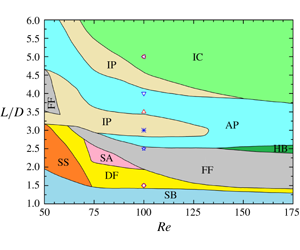Crossref Citations
This article has been cited by the following publications. This list is generated based on data provided by
Crossref.
Yan, Yuhao
Ji, Chunning
and
Srinil, Narakorn
2020.
Three-dimensional flip-flopping flow around a pair of dual-stepped circular cylinders in a side-by-side arrangement.
Physics of Fluids,
Vol. 32,
Issue. 12,
Wang, Jia-song
Fan, Dixia
and
Lin, Ke
2020.
A review on flow-induced vibration of offshore circular cylinders.
Journal of Hydrodynamics,
Vol. 32,
Issue. 3,
p.
415.
Chen, Weilin
Ji, Chunning
Xu, Dong
and
Zhang, Zhimeng
2020.
Oscillation regimes and mechanisms in the vortex-induced vibrations of three circular cylinders with equilateral-triangular arrangements.
Physics of Fluids,
Vol. 32,
Issue. 4,
Zhang, Zhimeng
Ji, Chunning
Chen, Weilin
Hua, Yang
and
Srinil, Narakorn
2021.
Influence of boundary layer thickness and gap ratios on three-dimensional flow characteristics around a circular cylinder in proximity to a bottom plane.
Ocean Engineering,
Vol. 226,
Issue. ,
p.
108858.
Bai, X.
Ji, C.
Grant, P.
Phillips, N.
Oza, U.
Avital, E. J.
and
Williams, J. J. R.
2021.
Turbulent flow simulation of a single-blade Magnus rotor.
Advances in Aerodynamics,
Vol. 3,
Issue. 1,
Liu, Bin
2021.
A Nitsche stabilized finite element method: Application for heat and mass transfer and fluid–structure interaction.
Computer Methods in Applied Mechanics and Engineering,
Vol. 386,
Issue. ,
p.
114101.
Deng, Nan
Noack, Bernd R.
Morzyński, Marek
and
Pastur, Luc R.
2021.
Galerkin force model for transient and post-transient dynamics of the fluidic pinball.
Journal of Fluid Mechanics,
Vol. 918,
Issue. ,
Cornejo Maceda, Guy Y.
Li, Yiqing
Lusseyran, François
Morzyński, Marek
and
Noack, Bernd R.
2021.
Stabilization of the fluidic pinball with gradient-enriched machine learning control.
Journal of Fluid Mechanics,
Vol. 917,
Issue. ,
Freidooni, F.
Sohankar, A.
Rastan, M.R.
and
Shirani, E.
2021.
Flow field around two tandem non-identical-height square buildings via LES.
Building and Environment,
Vol. 201,
Issue. ,
p.
107985.
Yan, Yuhao
Ji, Chunning
and
Srinil, Narakorn
2021.
On wake modulation and interaction features of a pair of dual-step circular cylinders in side-by-side arrangements.
Physics of Fluids,
Vol. 33,
Issue. 9,
Deng, Nan
Pastur, Luc R.
Tuckerman, Laurette S.
and
Noack, Bernd R.
2021.
Coinciding local bifurcations in the Navier-Stokes equations.
EPL (Europhysics Letters),
Vol. 135,
Issue. 2,
p.
24002.
Zhu, Hongjun
Chu, Xin
Yan, Zhiyin
and
Gao, Yun
2021.
Coupling response of flow-induced oscillating cylinder with a pair of flow-induced rotating impellers.
Physics of Fluids,
Vol. 33,
Issue. 8,
Blanchard, Antoine B.
Cornejo Maceda, Guy Y.
Fan, Dewei
Li, Yiqing
Zhou, Yu
Noack, Bernd R.
and
Sapsis, Themistoklis P.
2021.
Bayesian optimization for active flow control.
Acta Mechanica Sinica,
Vol. 37,
Issue. 12,
p.
1786.
Chen, Weilin
Ji, Chunning
Alam, Md. Mahbub
and
Yan, Yuhao
2022.
Three-dimensional flow past two stationary side-by-side circular cylinders.
Ocean Engineering,
Vol. 244,
Issue. ,
p.
110379.
Li, Ang
Shi, Shengmin
and
Fan, Dixia
2022.
Fluid Forces and Vortex Patterns of an Oscillating Cylinder Pair in Still Water With Both Fixed Side-by-Side and Tandem Configurations.
Journal of Offshore Mechanics and Arctic Engineering,
Vol. 144,
Issue. 2,
Dwivedi, Ajay Raj
Dhiman, Amit
and
Sanyal, Aniruddha
2022.
Stratified Shear-Thinning Fluid Flow Past Tandem Cylinders in the Presence of Mixed Convection Heat Transfer With a Channel-Confined Configuration.
Journal of Fluids Engineering,
Vol. 144,
Issue. 5,
Li, Yiqing
Cui, Wenshi
Jia, Qing
Li, Qiliang
Yang, Zhigang
Morzyński, Marek
and
Noack, Bernd R.
2022.
Explorative gradient method for active drag reduction of the fluidic pinball and slanted Ahmed body.
Journal of Fluid Mechanics,
Vol. 932,
Issue. ,
Lu, Jiaxing
Bi, Dianfang
Wang, Cong
Wei, Yingjie
Wang, Wenjun
and
Zhang, Dehua
2022.
Research on the interference characteristics of successively launched underwater projectiles.
Physics of Fluids,
Vol. 34,
Issue. 6,
Li, Feifan
Ji, Chunning
and
Xu, Dong
2022.
A novel optimization algorithm for the selective frequency damping parameters.
Physics of Fluids,
Vol. 34,
Issue. 12,
Wang, Yisen
Yang, Zhonghua
Yu, Minghui
Zhou, Haiyan
and
Zhang, Dawei
2022.
Study on flow characteristics and diversity index of diamond-type boulder cluster with different spacing ratios.
Environmental Science and Pollution Research,
Vol. 29,
Issue. 23,
p.
34248.

 $L/D(=1.0{-}6.0)$, Reynolds number
$L/D(=1.0{-}6.0)$, Reynolds number  $Re(=50{-}300)$ and three-dimensionality on the flow structures, hydrodynamic forces and Strouhal numbers, where
$Re(=50{-}300)$ and three-dimensionality on the flow structures, hydrodynamic forces and Strouhal numbers, where  $L$ is the cylinder centre-to-centre spacing and
$L$ is the cylinder centre-to-centre spacing and  $D$ is the cylinder diameter. The fluid dynamics involved is highly sensitive to both
$D$ is the cylinder diameter. The fluid dynamics involved is highly sensitive to both  $Re$ and
$Re$ and  $L/D$, leading to nine distinct flow structures, namely single bluff-body flow, deflected flow, flip-flopping flow, steady symmetric flow, steady asymmetric flow, hybrid flow, anti-phase flow, in-phase flow and fully developed in-phase co-shedding flow. The time-mean drag and lift of each cylinder are more sensitive to
$L/D$, leading to nine distinct flow structures, namely single bluff-body flow, deflected flow, flip-flopping flow, steady symmetric flow, steady asymmetric flow, hybrid flow, anti-phase flow, in-phase flow and fully developed in-phase co-shedding flow. The time-mean drag and lift of each cylinder are more sensitive to  $L/D$ than
$L/D$ than  $Re$ while fluctuating forces are less sensitive to
$Re$ while fluctuating forces are less sensitive to  $L/D$ than
$L/D$ than  $Re$. The three-dimensionality of the flow affects the development of the wake patterns, changing the
$Re$. The three-dimensionality of the flow affects the development of the wake patterns, changing the  $L/D$ ranges of different flow structures. A diagram of flow regimes, together with the contours of hydrodynamic forces, in the
$L/D$ ranges of different flow structures. A diagram of flow regimes, together with the contours of hydrodynamic forces, in the  $Re-L/D$ space, is given, providing physical insights into the complex interactions of the three cylinders.
$Re-L/D$ space, is given, providing physical insights into the complex interactions of the three cylinders.
